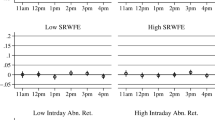Abstract
Recent studies of financial analysis' earnings forecast revisions following dividend announcements suggest that dividends convey information regarding a firm's future prospects. In this study, we extend the analysis by explicitly controlling for earnings information released during the forecast revision measurement period. Our results suggest that earnings forecast revisions previously attributed to dividend announcements are driven primarily by earnings surprise. At best, dividends appear to serve a corroborative role.
Similar content being viewed by others
References
Aharony, J., and I. Swary. 1980. “Quarterly Dividend and Earnings Announcements and Stockholders' Returns: An Empirical Analysis.”Journal of Finance 35: 1–12.
Asquith, P., and D. Mullins. 1983. “The Impact of Initiating Dividend Payments on Shareholders' Wealth.”Journal of Business 56: 77–96.
Bhattacharya, S. 1979. “Imperfect Information, Dividend Policy and the ‘Bird-in-the-Hand' Fallacy.”Bell Journal of Economics 10: 259–270.
Brickley, J. A. 1983. “Shareholder Wealth Information Signaling and the Specially Designated Dividend: An Empirical Study.”Journal of Financial Economics 12: 187–210.
Brown, L. D., and M. S. Rozeff. 1978. “The Superiority of Analyst Forecasts as Measures of Expectations: Evidence from Earnings.”Journal of Finance 33: 1–16.
Brous, A. 1992. “Common Stock Offerings and Earnings Expectations: A Test of the Release of Unfavorable Information.”Journal of Finance 47: 1517–1536.
Charest, G. 1978. “Dividend Information, Stock Returns and Market Efficiency.”Journal of Financial Economics 6: 297–330.
DeAngelo, H., L. DeAngelo, and D. J. Skinner. 1992. “Dividends and Losses.”Journal of Finance 47: 1837–1864.
Denis, J., D. K. Denis, and A. Sarin. 1994. “The Information Content of Dividend Changes: Cash Flow Signaling, Overinvestment, and Dividend Clienteles.”Journal of Financial and Quantitative Analysis 29: 567–587.
Eades, K. M. 1982. “Empirical Evidence on Dividends as a Signal of Firm Value.”Journal of Financial and Quantitative Analysis 17: 471–500.
Ely, K. M., and V. Mande. 1996. “The Interdependent Use of Earnings and Dividends in Financial Analysts' Earnings Forecasts.”Contemporary Accounting Research 13: 435–456.
Fried, D., and D. Givoly. 1982. “Financial Analysts' Forecasts of Earnings: A Better Surrogate for Earnings Expectations.”Journal of Accounting and Economics 4: 85–107.
Healy, P., and K. Palepu. 1988. “Earnings Information Conveyed by Dividend Initiations.”Journal of Financial Economics 21: 149–175.
John, K., and J. Williams. 1985. “Dividends, Dilution, and Taxes: A Signaling Equilibrium.”Journal of Finance 40: 1053–1070.
Kane, A., Y. K. Lee, and A. Marcus. 1984. “Earnings and Dividend Announcements: Is There a Corroboration Effect?”Journal of Finance 39: 1091–1098.
Lang, L. H. P., and R. H. Litzenberger. 1989. “Dividend Announcements: Cash Flow Signaling versus Free Cash Flow Hypothesis?”Journal of Financial Economics 24: 181–191.
Leftwich, R., and M. E. Zmijewski. 1994. “Contemporaneous Announcements of Dividends and Earnings.”Journal of Accounting, Auditing and Finance 9: 725–762.
Miller, M. H., and K. Rock. 1985. “Dividend Policy under Asymmetric Information.”Journal of Finance 40: 1031–1051.
O'Brien, C. P. 1988. “Analysts' Forecasts as Earnings Expectations.”Journal of Accounting and Economics 10: 53–83.
Ofer, A. R., and D. R. Siegel. 1987. “Corporate Financial Policy, Information, and Market Expectations: An Empirical Investigation of Dividends.”Journal of Finance 42: 889–911.
Pettit, R. R. 1972. “Dividend Announcements, Security Performance, and Capital Market Efficiency.”Journal of Finance 27: 993–1007.
White, H. 1980. “A Heteroskedasticity-Consistent Covariance Matrix Estimator and a Direct Test for Heteroskedasticity.”Econometrica 48: 817–838.
Yoon, P. S., and L. T. Starks. 1995. “Signaling, Investment Opportunities, and Dividend Announcements.”The Review of Financial Studies 8: 995–1018.
Author information
Authors and Affiliations
Corresponding author
Additional information
The authors gratefully acknowledge the contribution of I/B/E/S Inc. for providing earnings per share forecast data, available through the Institutional Brokers Estimate System.
Rights and permissions
About this article
Cite this article
Best, R.J., Best, R.W. Earnings expectations and the relative information content of dividend and earnings announcements. J Econ Finan 24, 232–245 (2000). https://doi.org/10.1007/BF02752605
Issue Date:
DOI: https://doi.org/10.1007/BF02752605




